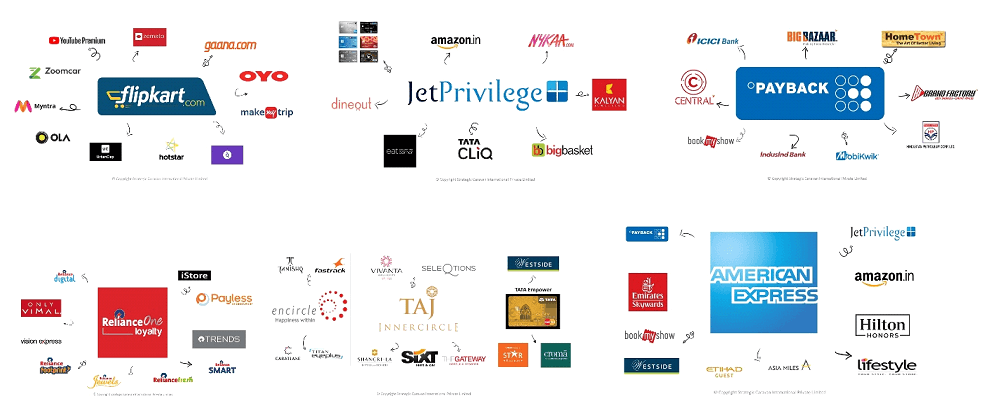Introduction to Coalition Loyalty Programmes:
Coalitions work best when the program partners are all targeting the same target audience or consumer segment, and are positioned with similar brand values. Bundling of complementary products and services is a common and powerful practice in marketing. In the world of loyalty, coalitions programs involve 4 or 5 principal brands collaborating to reward customer loyalty, with a common points currency and privileges across all brands. Participating sponsors in a coalition are typically a heady mix of:
- High-frequency, low value, (like grocery)
- Lower-frequency, high value offerings (like airlines and hotels)
- Low-value, high priced necessities (such as fuel and utilities)
- Aspirational, discretionary categories (like apparel/accessories, jewelry, dining and cosmetics)
- A payments device (Credit/debit cards or an e-wallet)
The more heterogeneous a population, the higher the opportunity to design targeted coalition programs (and variants). Invariably, points land up getting accumulated at regular usage categories like fuel and telecom and get redeemed for more aspirational and discretionary spends like dining, cosmetics and fashion!
India provides powerful opportunities for many principle coalitions – with an exciting assortment of variants!
Coalitions in India
Two organizations attempted to launch multi-brand coalitions in 2006. One was the Tata Group of companies (with the brand, Tata Empower) and the other was a subsidiary of ICICI Bank (with the brand ‘iMint’). Tata Empower launched an SBI co-branded credit card with sponsors like Westside and Croma, and iMint launched an ICICI bank credit card with HPCL, Airtel, Air India, Lifestyle and Makemytrip.com.
Tata Empower remained a relatively small niche player. iMint was acquired by Payback of Germany (subsequently acquired by American Express). And Jet Airways started an airline loyalty initiative (Jet Privilege) which quickly expanded partners to begin to look like a coalition program.
With the
advent of the telecom revolution, some other groups gathered a powerful
assortment of partners. The Reliance
Group has bundled complementary retail partnerships (within Reliance retail and
with telecom Jio), And Flipkart has cobbled together an impressive alliance of
partners and launched an independent currency (Super Coins).
An illustrative view of some of the leading coalitions in the country






Trending now
The bankruptcy of Jet Airways has forced Jet Privilege to seek a new destiny outside of its erstwhile principal sponsor. This morning, Jet Privilege rebranded itself to INtermiles.
So how will customers receive Intermiles in a market dominated by Payback, being courted by Flipkart Plus (and Super Coins a coalition program where members can earn Super Coins across a multiplicity of brands)? And what will this mean for American Express Rewards, as it continues its transformation into one of the most powerful Customer Loyalty programs?
And will the Tata Group create a common program from or continue with their 3 large independent efforts (1. Taj Inner Circle, 2. Tata Empower and 3. Titan Encircle? Interestingly, Mr.Chandrashekhar in his recent interview on CNBC, promised a Tata Customer platform launch in the middle of 2020).
And what will happen to Reliance One as it silently acquires a huge membership base (but remains primarily a Reliance enterprise-wide program)?
And this
does not even take into consideration Paytm and Amazon who form strong
alliances through their platform and offer immediate rebate on purchases.
Observations by Strategic Caravan
Some questions you could reflect upon when predicting success (or failures) of loyalty programs are:
- Do the programs offer synergistic brands that you as a customer transact with?
- Is the earning velocity of loyalty points offering an attractive proposition?
- What is the value proposition of the program apart from loyalty points for valuable and loyal customers?
- Most importantly, how many coalition programs will you be a member of?
- How many coalition programs can a country like India sustain? Few large or many smaller targeted by region?
- Which categories will drive acceptance? Credit cards? E-wallets? Ridesharing?
- How will programs differentiate themselves? By focus (eg. travel and hospitality) or by age / gender? Or by channel (on-demand vs. retail)? Or by socio-economic segmentation (luxury / economy / mass-affluent)? Or by geography? (City-wise Lite Coalitions)
Our view is that India is on the cusp of seeing a burst of loyalty programs that will create new segments, new markets and new brand affinities. There is ample room for many a coalition to play in a country as large and diverse as India, a few examples are:
- Programs for millennials,
- Program for Moms,
- Business-travel focused programs,
- Social program for supporting good causes,
- Local (geography-focused) programs etc.
Coalition programs will and must be led by targeted segment-specific strategy. These could have links to other programs but cannot violate the core if they need to be effective. Brands can and will be partners in many programs either as earn partners, burn partners, benefit partner, principal sponsor or tactical partner. Managing these relationships will be complex both from account management as well as revenue and cost accounting.
Whether it be a Tata, Reliance, Birla, Mahindra, Paytm, HDFC, or any other program, the one thing for sure is that brands will need to define their customers and create attractive value propositions for the segments they address.
Loyalty programs are in for the next set of changes – watch out for these and align yourself to the programs that give you the maximum benefit and align to your lifestyle. After all you are the customer and remember that they say the Customer is the King and the purpose of business is to identify and retain a customer.
Fasten your seatbelts and get ready for take-off!!!


Recent Comments